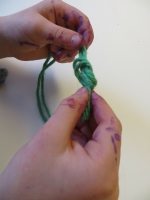Games to Play with String
 If you're looking for a versatile toy with tremendous developmental benefits, a simple length of string, rope, or yarn is the way to go. Here are some games you can play with that string that address various areas of a child's development. Many of these can be played anywhere! Keep yarn or string in your purse or pocket to pull out when your little one is getting bored and needs something fun and challenging to do.
If you're looking for a versatile toy with tremendous developmental benefits, a simple length of string, rope, or yarn is the way to go. Here are some games you can play with that string that address various areas of a child's development. Many of these can be played anywhere! Keep yarn or string in your purse or pocket to pull out when your little one is getting bored and needs something fun and challenging to do.
Balance and Coordination String, yarn, or rope makes a perfect balance beam. Stretch the string out on the floor, and show your child how to walk on it, putting one foot in front of the other. Your child can do lots of fun things on a balance beam:
- Walk on a curvy or zigzag line
- Balance on one foot on the string
- Do an arabesque (or scale)
- Jump zigzags back and forth across the string
- Hop on one foot either on the balance beam or from side to side
- Walk backwards
- Do forward rolls
- Walk on tiptoe on the beam
For more ideas, see this post.
Obstacle Course
Use yarn as a part of an obstacle course. Your obstacle course can include crawling through tunnels made from cardboard boxes, stepping up on stepstools and jumping down, balancing on a rope as it zigzags between cones (or just cups set on the ground), and bouncing on a cushion. The rope can mark the path through the whole course, or it can just form a balance obstacle.
Fine Motor Skills
A child can learn beginning weaving with just yarn and their hand. Have him hold up his non-dominant hand, fingers spread apart. Make a loop with a slip knot, and loop it around his thumb. Then have him weave the yarn back and forth around his fingers, looping around the pinky and coming back the other way.
Yarn finger games also help develop finger strength and dexterity. Remember cat's cradle from when we were kids? Here are some finger games you can play.
Art
Use string to make pictures on the ground. You can make pictures of animals (real or imaginary), shapes, letters, buildings, or anything your child can imagine. This is an easy, quiet activity for a waiting room or even at church or a meeting.
For a permanent string picture, dip the string in school glue, and then use your fingers to squeeze off the excess. Have your child put the string down on paper in the design she wants, and let it dry. After it's dry, she can color inside the design.
Treasure Hunt
Hide small toys around the house. Have a long piece of yarn form the path that the child needs to take to find all the objects.
Spatial Relationships
Children need to learn concepts like in, out, beside, around, over, and under. Learning these words and concepts will help them follow directions and stay safe (Stay beside the road. Don't go in the parking lot. Walk around the puddle.) Practicing spatial concepts with whole body involvement not only helps kids understand the concepts better, but it develops control over the body and coordination.
Try this: Make a square or circle with the yarn on the floor. Play a following-directions game. Kids can hop into the circle, jump out, put one foot in, put an elbow in, put their nose in, stand beside the circle, run around the circle. Have them follow commands faster or slower. Let them give you directions too.
Doll Play
Attach a length of yarn to a small doll or action figure. Kids can wrap up the doll then hold the end of the string and let the doll roll out, swing the doll, help the doll "mountain climb" up a chair. Outside, you can use sturdy string to let a doll go down a stream, and then pull it back again, or to go over small waterfalls and then rescue it.
Encouraging Cooperation
String can even help kids that may usually get fussy transitioning from one activity to the next. Before it's time to stop drawing to get ready for bed, for example, make a path of string leading to the bathroom and tied around your child's toothbrush. (Don't forget to give him a warning that it's almost time to stop drawing!) When it's time to stop, suddenly "discover" the string. Wonder aloud where it leads. Suggest that you follow the string together to find out what it's time to do next. This can turn the transition to a new activity into a game.
What else can you think of to do with string? Leave us a comment and tell us!
Related Posts
By accepting you will be accessing a service provided by a third-party external to https://growthandgiggles.com/

